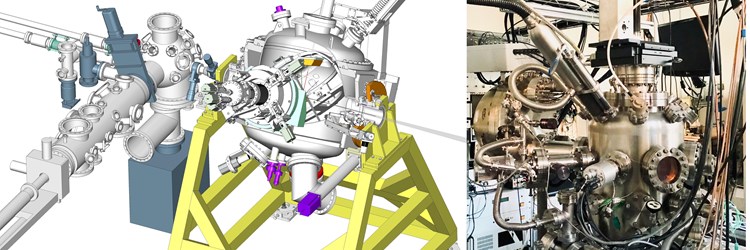

BEAR is part of a joint research unit - SEAL (Scattering Emission Absorption Lab) dedicated to optical and electronic properties of surfaces, interfaces and thin films.
BEAR (Bending Magnet for Absorption and Reflectivity) is part of a joint research unit - SEAL – participated by personnel from IOM Headquarters and University of Modena and Reggio Emilia dedicated to the study of the optical and electronic properties of surfaces, interfaces and thin films.
BEAR offers photon-in and photon-out, photon-in electron-out and electron scattering spectroscopies in a UHV environment. Excitation sources include photon sources (synchrotron with control of polarization state from linear to elliptical and variable s(TE)/p(TM) polarization incidence ratio, polarized UV lamp/He and X-ray source/Mg/Al, low energy sources in the Vis-UV range – Tungsten-Deuterium lamp, LED high intensity diodes 285-533 nm), ion and electron guns. A Photo Elastic Modulator is available. Experimental station are provided with Surface science class chambers for samples preparation (annealing, ion sputtering, scraping) and thin films depositions. Remote operation (of the BEAR beamline) is available.
Instrumentation: Dealing with photosensitive sample and with induced changes due to photon beam during measurement constitute a delicate aspect in photon-in spectroscopy. At BEAR beamline the problem has been faced at first evaluating and controlling the impinging power density vs energy, geometry and by an acquisition protocol whit selection of exposure time with possibility of acquiring at selected fresh sample regions
Polarized light and related phenomena: a secondary light exit of BEAR is equipped with a photo-elastic modulator to produce circular polarized light UV and concurrently a piezo-dichroic device based on LiF crystal is considered for polarimetric observation of sun corona.
Software: Physical ray tracing: the transport and monochromatization process of BEAR optics from source to sample has been analytically described developing a code written in Mathematica allowing to get the electromagnetic field (amplitude and phase) at the focal point.
Development of a code (OPAL – Optical Properties of Anisotropic Layers) for the simulation of the optical properties of anisotropic layered materials.
the BEAR/SEAL group's activity includes:
Organic thin films and related interfaces for OTFT, OLED, OLET, photovoltaics: characterization at nano- and micro-scale (through UPS, XPS, dichroic XAS and reflectivity) to model and optimize device performance.
Morphology, local atomic order and electronic properties and related simulations codes: currently addressed topics include chemisorption geometry of organic molecules at surfaces and their interfaces, thin film magnetic dichroism, atomic geometry evolution (NEXAFS) upon lithiation in nanostructured Li-ion electrodes based on carbon-coated spinel ferrites and nanowires coatings (XEOL).
Low electron energy driven chemistry: focus on the role of low energy tail of electron cascade associated to photo-electrons in the activation of chemical reaction. Attention is currently devoted to the solubility switch of protected polymers in photoresist blends of interest in photolithography at 13.5 nm.
Study of formation of C growth under synchrotron beam (R specular and diffuse, XAS, AES, XPS) on most currently used substrates (eg Pt, Au) and on microscopic study and monitoring of C removal in UV light excited gas environment.
Luminescence for the study of skin cancer alterations.
FAR, Lumina, 2019-2022
AHEAD2020, BABE